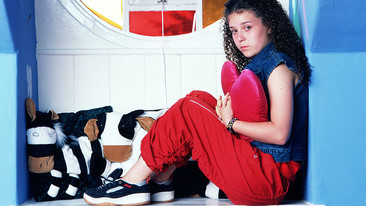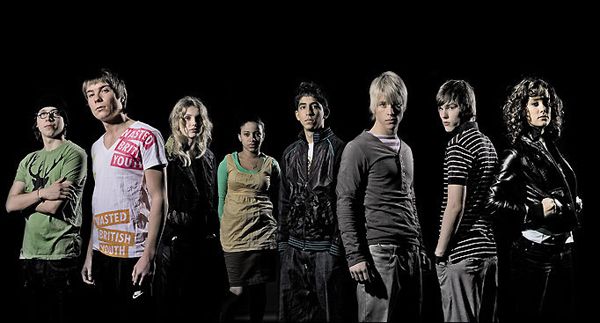Leon Festinger beleives we resist changing our opinions unless faced with overwhelming evidence against what we beleive. Cognitive disonance is when our brain encounters new ideas and rejects them because they don't match our expectations. This is subjective to opinion, it also works in the sense that overwhelming evidence can change your opinion on something as it seems more plausable.
We then watched everybody elses prezi presentation on seven stereotypes re-presentated in the media.; all of these views are not mine they are ones that appear to be portrayed in the media.
Age
Children; Children in the media are played as the same age of the target audience. e.g Tracey Beaker/ kids at the dumping ground are all the ages of the target audience. The media portray children to be good people so that the children watching aspire to be like them.
12-14 year olds; nearly always play cool characters who lead action packed, interesting lives, they always play the good guys e.g M-I-High, again it gives something for the target audience to look up to.
15-18 year olds; Never normally played as 'normal' teenagers. You have one end of the spectrum, such as skins where all the teenagers are seen as druggies, dropouts, violent people who lead exciting lives going out partying getting off their face which is, lets face it, hardly like the lives of teenagers i know. Then the other end of the scale would be The Inbetweeners, which shows social rejects and their struggle on getting girls and getting through the hurdles of teenage life. That is more realistic but obviously not a match to everybodies life. Characters such as Vicky Pollard are used to discourage mid teenagers becoming like that. People look down on her and take the piss out of her which makes her a bad role model and would make people avoid being like her. Older people (30+)
20-30; Hollyoaks represents the idea that when you're younger you dress older and when you're older you dress to look younger. It reflects that the 20's is the prime time of your life and everyone is successful.
Eastenders shows that you get more sophisticated as you enter your 30's, e.g drinking wine instead of alcopops and that women dress more their age, more glamorous. It shows men being more successful, dressed in suits.
Elderly people are re-presentated as being old, mardy, weak, not with it, complaining or contrastingly as a happy chappy 'war hero'.
Ability & Disability
There are many typed of disabilites, but the one the media foucuses on is people bound to a wheelchair. Disabled people are typically seen to be wearing comfy clothes, as they are viewed to be housebound and don't actually need to get out of their wheelchair. Normally characters in wheelchairs are vunerable, don't make much effort and aren't energetic. This depicts disabled people. Andy and Lou from Little Britain make full use of the stereotypical disabled person. The settings of Andy's house is untidy and dirty, implies that because he's in a wheelchair he can't do day to day chores.
The camera nagle tends to look down or at a disabled person, never looks up to them. It is common that the carer is in the image with the disabled person, rather than focusing on the individual person. Another thing that doesn't focus on the individual person is when you hear stories of disabled people doing well, e.g if someone who had lost their legs and had fake ones put on and ran a marathon, would get a lot more praise than someone who had both of their own legs. This re-inforces that non-disabled people patronize disabled people. The personality traits of disabled people in the media are either that they are evil, or stupid. There's rarely a normal character in a wheelchair.
Gender
The toilet sign is something we all recognise, it gives the cultural signal of women wearing skirts and dresses, and men having broad shoulderrs and having thicker legs/arms than women. Nobody challenges this or gets 'mixed up' on what toilet to go into as this is what we accept a sign for female and male toilets. Stereotypically males are seen to be wearing trousers, short hair, strong, earn more money, working, bigger.
 Women are seen to have long hair, not physically as strong as men, less responsibility and to be a typical housewife. The picture shows a 1950's woman getting pies out of the oven. This image shows a typical 'housewife' getting pies out of the oven, the child in the image also represents how women were supposed to stay at home, raise children and put dinner on the table for when the
Women are seen to have long hair, not physically as strong as men, less responsibility and to be a typical housewife. The picture shows a 1950's woman getting pies out of the oven. This image shows a typical 'housewife' getting pies out of the oven, the child in the image also represents how women were supposed to stay at home, raise children and put dinner on the table for when thehusband ges home. Jokes people make nowadays about women being in the kitchen relates back to this. In contemporary soaps males are seen as the supporters, 'stoic', never the other way round. The women are seen as 'wearing their heart on their sleeve' and don't tend to control their emotions. The physical fighting in soaps , 9/10 times is done by men, if it is done by women its more of a bitch fight. It perpetuates stereotypical views, if you type fight into google, no images of women come up.
Regional Identity
Northeners- People are friendly yet reject anyone from the south. They are portrayed to moan a lot and consume a lot of alcohol. On average they live a 'lower class' life, and that more crime happens compared to the south. In this clip Frankie Boyle portrays scottish people by picking and exaggerating certain stereotypes.
Southeners- They seem to live a more upbeat lifestyle, mainly based around cities. They have a more 'Newsreader' Accent, which is easier to understand but is labelled 'posh'. They are more forward about subjects.
Countryside - From places such as the west country or Norfolk, are harder to understand and maybe seen as not ' with the times ' . Also seen as farmers, they wear more relaxed clothes, have more rural jobs e.g farmers and are seen to have a more physical working lifestyle. This clip from hot fuzz exaggerates the west country accent.
Ethnicity
Hoodies are portrayed to be the sort of clothes that make people unnaproachable, and black people are normally seen to be wearing them. This enforces that black teenage/early 20's boys are thugs.·That they are lazy, don't want to work or help the community. This stereotype is challenged in Hollyoaks by a young black male (Calvin) is a police officer and therefore is helping the community.
It is also seen in British television that a majority of the actors are white, emphasising people of a different ethnicity are a minority and different.
Sexuality
Gay Male's wear tightly fitted clothing, are more into fashion and style than hetrosexual men, they like to spend their time out clubbing with girl friends, and often take part in gay parades.
Mr G in summer heights high is how you would expect a gay middle aged man to behave. He is into performing arts and is quite affeminate the way he speaks and acts.
He's quite bitchy aswell which is a trait that is normally associated with girls. He also has a 'handbag' dog called celine, handbag dogs are also seen to be something girls would have.
Plots tend to include coming out, how they cope and the abuse that suffers. This is focussing on the negative points of being homosexual. Lesbians are also portrayed in the media as having short hair, being butch, into contact sports such as rugby, deeper voices and act manly.
Status & Class
Mine and Jordan's Prezi presentation was on Status and Class;
We found that there are three main 'classes'; upper class, which is royalty, lords, dukes, and millionaires. Middle class; which is everyday people. Most of us fit into that category. Lower class; chavs, homeless people.
We associate the 'upper class' people to be rich, play sports such as polo and cricket, go fox hunting, live in mansions, have lots of jewells/diamonds, wear tweed, have afternoon tea, have a butler and drive a bentley. Usually people with higher class have the upper status in the media, and tend to have control of the situation.
Middle class is what we would consider 'normal' people, living in a semi-detached house, do normal things such as go to festivals, shopping with friends, have jobs such as teachers or bankers and have the typical 2.4 children. Outnumbered is a good representation of a middle class family. The setting is in a house and the situations that happen are not far from real life. The song ' The day I died' by Just Jack describes (up until the death) a typical day of a middle classed person ' drag myself from my bed, around twenty past six, get my kids up make breakfast 1 egg 2 toast 3 weetabix ' seems like a realistic routine that middle class people do.
Working class is seen as Chavs, wearing baseball caps, living in council houses. Bianca from Eastenders talks like you would expect someone from a lower class to, with a strong cockney accent. This indicates she isn't well educated and is a bit gobby. They are also related to not having much money.






This is a really comprehensive post. You show a good 'wider' knowledge of the issues surrounding the representation areas.
ReplyDeleteMy one request would be that you either disable the auto play function on your mixpod (you have loads of Killers tracks yet I always get Enrique!) or update it. If you like the Killers then, if you haven't already, listen to 'The Gaslight Anthem' The 59 sound album and put that on your mixpod to make marking your work easier.